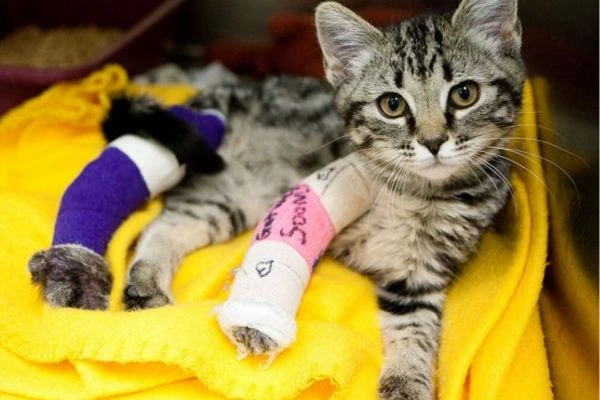Cats are extremely feral.
They are curious and always on the lookout for something dangerous. Because they are playful, they will always land in trouble.
While their injuries can range from minor bruises to major wounds, it is always best to keep a first aid kit handy.
We bring to you an article that lists all the must-haves along with tips to treat common emergencies.
Must-Have Items in a Cat First-Aid Kit
1. Digital Thermometer
A cat’s normal body temperature ranges between 100°F and 103°F. A digital rectal thermometer is essential for checking if your cat has a fever or is hypothermic.
Always use a lubricant (like petroleum jelly) and only attempt this if your cat is calm or restrained. Fever or abnormally low temperature can signal infection, heatstroke, or shock.
Having this tool helps you detect illness early. Never use human ear thermometers on cats—they’re not accurate for feline use. Record your cat’s normal temperature when healthy for comparison.
2. Sterile Gauze Pads and Rolls
These are essential for wrapping wounds, stopping bleeding, or creating makeshift bandages. Use them to apply gentle pressure to cuts or to absorb blood or pus.
Gauze rolls can secure dressings in place without adhesives that irritate fur or skin. Sterile materials reduce the risk of infection. Always ensure your hands or gloves are clean before handling gauze.
Avoid wrapping too tightly—cut off circulation and worsen injuries. Replace gauze every few hours or after it becomes soiled.
See Also:
-
How Common Are White Cats With Green Eyes? The Answer Will Surprise You!
-
Cats that are Endangered or Critically Endangered (Rarest Cats in the Wild)
3. Pet-Safe Antiseptic (Chlorhexidine or Betadine)
For cleaning wounds and preventing infections, antiseptics like chlorhexidine or diluted Betadine are safe for cats. These solutions kill bacteria and reduce inflammation without stinging as much as alcohol or hydrogen peroxide.
Always dilute Betadine until it looks like weak tea. Avoid anything with hydrogen peroxide or alcohol—they can delay healing or damage tissue. Use a cotton ball or pad to gently dab wounds. Clean only once or twice a day unless directed by a vet. Rinse with sterile saline if needed.
4. Tweezers
Sharp, fine-point tweezers help remove splinters, ticks, or debris from your cat’s skin or paws. Always sanitize tweezers before and after use. If removing a tick, grip it as close to the skin as possible and pull straight out—twisting can leave parts behind.
Check the site for swelling or redness after removal. Never squeeze a tick’s body, as it may inject pathogens into your cat. After removal, clean the area with antiseptic. Save the tick in a sealed bag for identification if symptoms develop later.
5. Styptic Powder or Pencil
This is used to stop bleeding from minor cuts or nail trims. If you accidentally clip a nail too short, apply styptic powder directly to the bleeding area with pressure.
It causes rapid clotting and seals small vessels. If you don’t have styptic, cornstarch or baking flour can work in a pinch. Avoid using it on deep or open wounds.
Make sure your cat doesn’t lick the treated area. Always follow up with gauze or a bandage if bleeding continues.
6. Adhesive Tape or Vet Wrap
Vet wrap is a flexible, self-adhesive bandage that holds gauze in place without sticking to fur. It’s ideal for injured paws, minor wounds, or keeping dressings secure.
Use light tension to wrap—not too tightly. Adhesive medical tape can also secure bandages but may require trimming fur for a good hold. Keep scissors nearby to cut the wrap.
Replace the bandage every 24 hours or if it becomes wet or dirty. Watch for swelling or discoloration—signs it’s too tight.
7. Disposable Gloves
Always wear gloves when treating wounds, dealing with vomit, or administering medicine. Gloves help prevent the spread of bacteria, parasites, or other infectious agents.
Latex or nitrile gloves are best; keep a few pairs sealed in a bag. Replace after each use. Gloves also protect you from being scratched if your cat is distressed. They’re a hygienic barrier during emergencies. Always dispose of used gloves properly.
8. Sterile Saline Solution
Saline is useful for flushing out eyes, wounds, or cleaning debris. It’s gentle, non-stinging, and safe for internal or external use. Great for eye irritation or washing out a small cut.
You can buy pre-packaged sterile saline or make your own with boiled water and salt (cooled). Use a syringe or dropper for application. Always flush in the direction away from the body. Replace opened bottles every few days to avoid contamination.
9. Cat-Specific Medications (Vet-Approved)
Include any prescribed medications your cat takes regularly, along with items like antihistamines (e.g., Benadryl, if vet-approved), or anti-nausea pills. Store them in labeled containers with dosage instructions.
Keep medications in a waterproof bag. Always check expiration dates. Never use human medication unless a vet has approved it for your cat. Include your vet’s contact number and instructions for emergencies.
10. Emergency Contact Information
Include your vet’s number, the nearest 24/7 emergency clinic, poison control hotline, and a copy of your cat’s medical records. Keep everything in a waterproof sleeve or bag.
You never know when you’ll need to reference vaccine history or allergies. If someone else has to care for your cat, these records will be a lifesaver. Include your cat’s microchip number and medication list, too.
Common Cat Emergencies and What to Do
1. Wounds or Cuts
Clean with saline, apply antiseptic, and cover with sterile gauze. Monitor for swelling or infection. If deep or bleeding won’t stop—see the vet.
2. Tick or Insect Bite
Remove tick with tweezers, clean area with antiseptic, and monitor for lethargy or fever. Bites around the eyes or mouth? Seek vet help.
3. Poison Ingestion
Call poison control and your vet immediately. Do not induce vomiting unless instructed. Save the packaging of what they ate.
4. Vomiting or Diarrhea
Remove food for 12 hours, offer water, and monitor. If symptoms persist for more than 24 hours or are paired with lethargy—go to the vet.
5. Eye Irritation
Flush with sterile saline. If squinting or discharge continues after a few hours, consult your vet.
6. Limping
Check for stuck thorns or glass. Rest and restrict movement. If limping lasts more than a day or there’s swelling, seek medical attention.
A first aid kit comes always handy for the immediate treatment.
Always consult a vet in case of doubts.

Nikita Rout is a passionate content writer at HowItSee.com, where she explores the wonders of animals, nature, and the curious questions that spark our imagination. With a love for research and a knack for simplifying complex topics, she brings clarity and creativity to every article she writes. When she’s not writing, you’ll likely find her reading about animal behavior or coming up with unique pet name ideas.

